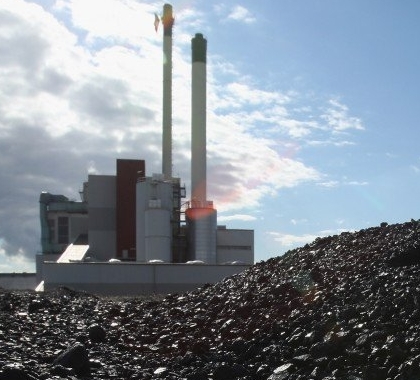Democrat Party politics are increasingly being driven by the extreme Left, with party leaders taking the fringe demands of radical environmentalists and progressive socialists more seriously than the concrete concerns average Americans have for decent jobs and affordable goods and services, which require relatively cheap and reliable energy.
The difference between Democrats and President Donald Trump is evident across a range of issues, but nowhere, perhaps—outside of “Russian collusion” claims and illegal immigration—is it starker than on the issue of climate change and the continued need for fossil fuels. Democrats mistakenly believe fossil fuel development, transportation, and use necessarily comes at the expense of the environment. By contrast, as Trump noted in his Earth Day speech, domestic energy development is not only compatible with high environmental quality, it helps make possible a clean, healthy environment that all can enjoy.
“Environmental protection and economic prosperity go hand in hand,” said Trump in his Earth Day message. “A strong market economy is essential to protecting our critical natural resources and fostering a legacy of conservation.
“My Administration is committed to being effective stewards of our environment while encouraging opportunities for American workers and their families,” Trump said. “At the same time that our Nation is experiencing historic economic and job growth, our air and water quality ranks among the highest in the world.”
Democrat leaders on the left coast and in New Mexico and Colorado, by contrast, have enacted or are considering legislation to tax fossil fuel use; restrict coal, natural gas, and oil development; or mandate ever-greater amounts of renewable energy be imposed on ratepayers. On the East Coast, Democrat leaders in Massachusetts and New York have erected government roadblocks to new natural gas and oil pipeline construction. Democrats in these states are in the grips of climate change fever, passing legislation that will cost their states jobs and revenues, increase the price of energy for residents and businesses, and undermine Trump’s push for U.S. energy dominance (perhaps their true goal), all in the vain hope of controlling the weather 100 years from now.
In contrast to blue-state Democrats, Trump as president has consistently put people’s needs before climate fears. Trump recognizes the best evidence does not support the theory human energy use is causing catastrophic climate change. As part of his effort to increase high-paying employment, Trump has consistently pushed policies to make the U.S. energy-independent by expanding the development and use of domestic supplies of coal, natural gas, and oil. That’s why he rolled back Obama-era regulations hampering coal, natural gas, and oil production on public lands, rewrote Obama’s regulations that prematurely shuttered coal power plants and hampered coal mining, and withdrew the United States from the Paris climate agreement.
His efforts have paid off with the highest economic growth rate in more than a decade, the lowest unemployment rate in nearly 50 years, and the United States becoming the world’s largest oil producer and soon to be a net energy exporter. The latter, by making our allies in Europe and around the globe less dependent on energy from Russia and OPEC, also improves our and their national security.
As a continuing part of his America First energy agenda, Trump recently signed two executive orders to speed approval of multistate pipelines, liquefied natural gas terminals, and cross-border infrastructure projects. Trump unveiled the orders in a speech at the International Union of Operating Engineers International Training and Education Center in Crosby, Texas on April 10.
One order Trump issued directs the federal government to make all permitting decisions concerning pipelines or other energy infrastructure projects that cross international borders within 60 days, and it gives the president the exclusive responsibility to “issue, deny, or amend” such permits.
Trump’s second energy executive order directs the U.S. Environmental Protection Agency (EPA) to review and modify what the order refers to as an “outdated” section of the Clean Water Act that requires applicants requesting federal permits for energy infrastructure projects that might affect federally protected waters to get certification from states where any potential contamination could happen. Under the order, EPA is expected to limit both the amount of time states have to consider pipeline and infrastructure permits and the reasons states can give for blocking permits.
“Under this administration, we have ended the war on American energy like never before,” said Trump in his Texas speech. “Since the election, we have created more than 5.5 million new jobs and more than 60,000 brand-new oil and gas pipeline construction jobs.
“But too often, badly needed energy infrastructure is being held back by special-interest groups, entrenched bureaucracies, and radical activists,” Trump said. “This obstruction does not just hurt families and workers like you; it undermines our independence and national security.”
These two executive orders promote the national interest by speeding up the approval process for energy infrastructure, says Trump.
“My first order will speed up the process for approving vital infrastructure on our nation’s borders, such as oil pipelines, roads, and railways,” Trump said. “It will now take no more than 60 days … [a]nd the president, not the bureaucracy, will have sole authority to make the final decision when we get caught up in problems. My second order will modernize regulations for LNG export terminals and encourage new infrastructure financing. … And finally, it will stop state-level abuse of water quality certifications—they abuse you; when you’re nowhere near water, they abuse you—from blocking the construction of vital pipeline projects as we rebuild our energy infrastructure.”
Analysts at The Heartland Institute praised Trump’s action.
Tim Huelskamp, Ph.D., president of The Heartland Institute, says Trump’s executive orders promote America’s national and economic security.
“For years, far-left politicians have abused their authority and deprived America of much-needed energy infrastructure,” said Huelskamp in a press release. “This executive order by President Donald Trump is just what is needed to create thousands more high-paying jobs in the energy industry, protect U.S. national security, and enhance the reliability and affordability of America’s energy supply.”
Senior Fellow James Taylor said, “President Trump’s executive order is long overdue. Environmental extremists and radical politicians in deep-blue states overstep their bounds when they shut down the transportation of energy sources based on politicized, anti-science agendas. The rest of America should never be allowed to be victimized by such highway, railway, and pipeline banditry.”
While Democrats bloviate about the end of the world from global warming, simultaneously promoting costly policies that would do nothing to prevent it, President Trump is advancing a bold agenda that puts Americans’ desire for ever-improving standards of living and U.S. economic and national security front and center.
- H. Sterling Burnett
SOURCES: The Heartland Institute; The Heartland Institute; National Public Radio; White House; The Heartland Institute; Nongovernmental International Panel on Climate Change; The White House
IN THIS ISSUE …
Clouds continue to confound climate models … Call for Environment Canada to stop climate forecasting
CLOUDS CONTINUE TO CONFOUND CLIMATE MODELS
In an interview with the German magazine Der Spiegel, Bjorn Stevens, director of the Atmosphere in the Earth System at the Max Planck Institute for Meteorology, says climate models continue to make “imprecise” predictions because the computer modelers still can’t account for fundamental feedback mechanisms, primarily the formation and behavior of clouds, on a regional and global scale.
Without understanding clouds, computer models can’t accurately calculate climate sensitivity. According to the Google translation of the Der Spiegel article on Climate Etc.,
Back in the 1970s, [climate sensitivity] was determined using primitive computer models. The researchers came to the conclusion that their value is likely somewhere between 1.5 and 4.5 degrees.
This result has not changed until today, about 40 years later. And that’s exactly the problem.
The computational power of computers has risen … but the prediction of global warming is as imprecise as ever.
Our computers do not even predict with certainty whether the glaciers in the Alps will increase or decrease.
Stevens says clouds—the huge amount of water vapor that slowly moves across and cycles in and out of the atmosphere—are the bane of climate models. There is an enormous diversity of clouds, with different types allowing different amounts of solar radiation to reach and reflect back off of the earth’s surface. Cloud formation depends heavily on local conditions, which are not accurately accounted for in climate models. Small changes in cloud cover can have large effects, a fact that is also true for other natural events models fail to accurately account for.
For instance,
… problems are caused by the small-scale details: the air turbulence above the sea surface, for example, or the wake vortices that leave mountains in the passing fronts. Above all, the clouds: The researchers cannot evaporate the water in their models, [to] rise and condense, as it does in reality. You have to make do with more or less plausible rules of thumb.
“Parametrization” is the name of the procedure, but the researchers know that, in reality, this is the name of a chronic disease that has affected all of their climate models. Often, different parameterizations deliver drastically divergent results. Arctic temperatures, for example, are sometimes more than ten degrees apart in the various models. This makes any forecast of ice cover seem like mere reading of tea leaves.
SOURCES: Der Spiegel (behind paywall); Climate Etc.
CALL FOR ENVIRONMENT CANADA TO STOP CLIMATE FORECASTING
Because climate research has become so politicized and the agency has repeatedly made failed climate forecasts, a recent article argues “Environment and Climate Change Canada (ECCC) should cease researching climate and making forecasts,” focusing its efforts instead solely on collecting and providing accurate data.
The Toronto Sun points out ECCC spectacularly failed to forecast the extremely cold 2018/2019 winter across much of Canada.
In September 2018, ECCC’s senior climatologist David Phillips predicted the winter of 2018 through 2019 would be a “milder than normal winter.” Instead, “Record cold temperatures were set across the country and more severe snowstorms occurred from coast to coast this winter … [with] 500,000 square kilometres more Arctic sea ice this year than at the same time last year. Lakes Superior, Huron, and Erie are 95 percent ice covered.”
From Saskatoon to Calgary to Vancouver, record-cold temperatures were recorded, forcing Phillips to admit, “I’m impressed, we’re talking about more than 25 degrees colder than it should have been,” (emphasis mine), meaning 25 degrees colder than ECCC forecast.
In the 1940s Swedish-American meteorologist Carl Rossby explained how shifts in the jet stream around the poles could cause arctic air to flow into more-temperate regions. ECCC and other international climate agencies that contribute to the Intergovernmental Panel on Climate Change, repeatedly make failed projections because, in the words of the Toronto Sun article’s authors, “after the anthropogenic global warming … deception appeared on the scene in the 1980s, all normal meteorology and climatology effectively ended. The deliberately narrow and premeditated science of the … IPCC focuses only on human causes of change. This eliminated natural causes, including solar and major planetary mechanisms.”
“The sad, but delicious, irony is that the Farmer’s Almanac that began forecasting in 1792, predicted a very cold snowy winter for most of Canada,” write the authors, comparing the Almanac’s accurate forecast, which took into account the “Rossby Wave pattern,” to ECCC’s grossly mistaken one, which didn’t.
SOURCE: Toronto Sun





